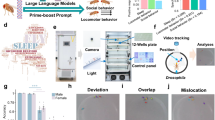Abstract
Chirocephalus: The best explanation of the peculiar inverted swimming position of many Anostraca and Notostraca is that advanced by Lowndes1 who, when directing attention to the respiratory function of the appendages, suggested that the attitude is concerned with respiration, for in this position the appendages can be brought into contact with the uppermost and best aerated layer of water.
This is a preview of subscription content, access via your institution
Access options
Subscribe to this journal
Receive 51 print issues and online access
$199.00 per year
only $3.90 per issue
Buy this article
- Purchase on Springer Link
- Instant access to full article PDF
Prices may be subject to local taxes which are calculated during checkout
Similar content being viewed by others
References
Lowndes, Proc. Zool Soc. Lond., 1093 (1933).
McGinnis, J. Exp. Zool, 10, 227 (1911).
Seifert, Z. vergleich. Physiol., 11, 386 (1930).
Cannon, Phil. Trans., 222, 267 (1933). Proc. Roy. Soc., B, 117, 455 (1935).
Foxon, J. Mar. Biol. Assoc., 19, 829 (1934).
Author information
Authors and Affiliations
Rights and permissions
About this article
Cite this article
FOXON, G. Orientation of Chirocephalus and Daphnia. Nature 137, 948–949 (1936). https://doi.org/10.1038/137948a0
Published:
Issue Date:
DOI: https://doi.org/10.1038/137948a0
Comments
By submitting a comment you agree to abide by our Terms and Community Guidelines. If you find something abusive or that does not comply with our terms or guidelines please flag it as inappropriate.



